Windsor, Berkshire, England, UK – Sunday, May 23rd, 2010
Today would be an exciting day. Not only was it my first theme park in the United Kingdom, it would also be the first park in all of Europe that I wouldn’t be visiting alone. After the first week of moral philosophy classes in London I found two expatriate companions willing to accompany me on a visit to Legoland Windsor for the day, with Windsor Castle thrown in on the side. The sun was already high in the sky when I woke up early that morning (I knew Scandinavia had endlessly long summer days but wasn’t aware that England was also similar; whenever I saw a movie in which a character wakes up at 5:30 or 6:00am in broad daylight I figured that was the work of lazy grips or DPs, but now I realize that could very well be accurate), I now just needed to gather Dan and Mark to commence the day.
“I think I’m still a little drunk from last night,” Dan croaked after I shook him from his deep slumber.
“So, that still means you’ll be ready to go to Legoland in ten minutes, right?”
(Cue the long pause as I hovered over him expectantly)
“Uh… sure. Let me just take a shower first.”
A true moral philosopher, never one to let a pal down. Fifteen minutes later the three of us were out the door and on the way to London Waterloo to pick up our rail and admission tickets to Windsor. South West Trains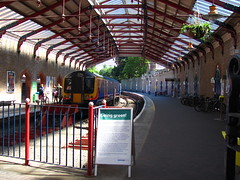 offers numerous packaged deals for daytrips on their lines, so when we got to the ticket office we tried purchasing our tickets to both Windsor Castle and Legoland. This seemed to confuse the receptionist somewhat whose terse clarifications confused us even more (are we really the first people to have ever thought to do both Legoland and Windsor Castle on the same day?), and when we boarded the train we each only carried a ticket for Windsor Castle with advice that Legoland tickets are purchased at the gate.
offers numerous packaged deals for daytrips on their lines, so when we got to the ticket office we tried purchasing our tickets to both Windsor Castle and Legoland. This seemed to confuse the receptionist somewhat whose terse clarifications confused us even more (are we really the first people to have ever thought to do both Legoland and Windsor Castle on the same day?), and when we boarded the train we each only carried a ticket for Windsor Castle with advice that Legoland tickets are purchased at the gate.
Almost instantaneously after arriving at Windsor & Eton Riverside (which includes a nice view of the Battersea Power Station on the way out of London; the Pink Floyd fans got to geek out momentarily after looking out the window and seeing an unexpected sight) we found ourselves staring up at the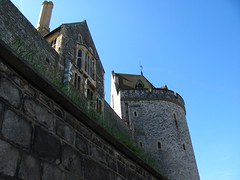 imposing exterior of Windsor Castle. After handing over our tickets and being patted through security, we were granted exclusive access to view that same exterior from a different vantage point: the interior
imposing exterior of Windsor Castle. After handing over our tickets and being patted through security, we were granted exclusive access to view that same exterior from a different vantage point: the interior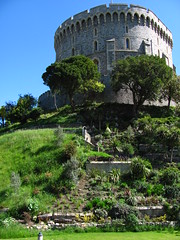 courtyard. Much picture taking of the green grasses and landscaping arranged in front of tall grey brick walls and towers followed, as we all meanwhile longed for a more descriptive guide to tell us how important each of these turrets were. Maybe I was partly spoiled by the Palacio Real in Madrid, but somehow I expected the tour of the world’s largest inhabited castle would be a bit more impressive; in reality, I discovered that the fact that it was still inhabited by royalty meant that tourists sure as hell weren’t going to go anywhere on the grounds where they would be getting in the way (I guess that’s what Buckingham Palace is now for, which we never got around to seeing). And so we joined the queue for the sole fraction of the castle that was open to visitors.
courtyard. Much picture taking of the green grasses and landscaping arranged in front of tall grey brick walls and towers followed, as we all meanwhile longed for a more descriptive guide to tell us how important each of these turrets were. Maybe I was partly spoiled by the Palacio Real in Madrid, but somehow I expected the tour of the world’s largest inhabited castle would be a bit more impressive; in reality, I discovered that the fact that it was still inhabited by royalty meant that tourists sure as hell weren’t going to go anywhere on the grounds where they would be getting in the way (I guess that’s what Buckingham Palace is now for, which we never got around to seeing). And so we joined the queue for the sole fraction of the castle that was open to visitors.
 It started with Queen Mary’s Dolls’ House (the secondary apostrophe making it a rather appropriate title, given it was of such a scale that the term ‘dollhouse’ would seem a pejorative), continued into a room filled with letters and drawings from notable individuals, and concluded with the state apartments, where numerous suits of armor and other expensive collectables were contained, and the ‘royal style’ of interior decoration was in full force (the goal is to use so much gold leaf and busy, lacy designs that it pounds the viewers visual processing abilities into oblivion). Stepping back out into the bright English sun, we concluded that both St. George’s Chapel and the daily guard change don’t occur on Sundays, and with nothing else indicating for us to see Windsor Castle was apparently already through with us about an hour and a half after our arrival (and we were quite thorough in our inspection of the place, I imagine if in a rush one could finish in less than 45 minutes). A leisurely pace around more of the upper ward and we soon found our exit. After a quick lunch of hot roasted pork rolls we ventured on board the bus to take us to the front gate of Legoland Windsor.
It started with Queen Mary’s Dolls’ House (the secondary apostrophe making it a rather appropriate title, given it was of such a scale that the term ‘dollhouse’ would seem a pejorative), continued into a room filled with letters and drawings from notable individuals, and concluded with the state apartments, where numerous suits of armor and other expensive collectables were contained, and the ‘royal style’ of interior decoration was in full force (the goal is to use so much gold leaf and busy, lacy designs that it pounds the viewers visual processing abilities into oblivion). Stepping back out into the bright English sun, we concluded that both St. George’s Chapel and the daily guard change don’t occur on Sundays, and with nothing else indicating for us to see Windsor Castle was apparently already through with us about an hour and a half after our arrival (and we were quite thorough in our inspection of the place, I imagine if in a rush one could finish in less than 45 minutes). A leisurely pace around more of the upper ward and we soon found our exit. After a quick lunch of hot roasted pork rolls we ventured on board the bus to take us to the front gate of Legoland Windsor.
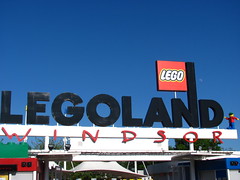 We decided to try going to guest services first to see if we still couldn’t get the South West Trains promotion applied to our tickets. I suspected we were only allowed one discount admission per rail ticket, but advised Mark and Dan not to voluntarily relay that bit of information when recounting the story. I myself needed to go to the season pass center to get a Merlin Annual Pass, as I calculated based on my planned future activities it would be slightly more cost-effective than buying tickets individually. I exited the booth, bank account a little less intact, but now the proud owner of my first ever foreign season pass… proof I was becoming a true cosmopolitan globetrotter! Even better news, when I reconvened with Dan and Mark, they said that after explaining our story not only were they able get the originally promised
We decided to try going to guest services first to see if we still couldn’t get the South West Trains promotion applied to our tickets. I suspected we were only allowed one discount admission per rail ticket, but advised Mark and Dan not to voluntarily relay that bit of information when recounting the story. I myself needed to go to the season pass center to get a Merlin Annual Pass, as I calculated based on my planned future activities it would be slightly more cost-effective than buying tickets individually. I exited the booth, bank account a little less intact, but now the proud owner of my first ever foreign season pass… proof I was becoming a true cosmopolitan globetrotter! Even better news, when I reconvened with Dan and Mark, they said that after explaining our story not only were they able get the originally promised discount, they were given tickets discounted even further to only half the normal price! Now I didn’t feel quite so guilty about dragging them along
discount, they were given tickets discounted even further to only half the normal price! Now I didn’t feel quite so guilty about dragging them along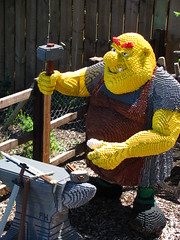 to what was in effect a children’s park.
to what was in effect a children’s park.
I’m not entirely sure if I knew what to expect from Legoland. I’ve enjoyed my time at other traditional children’s parks like Chicago’s Kiddieland, Dutch Wonderland or Paris’s Jardin d’Acclimatation. Given that it was an internationally recognized branded park operated by the same group as Alton Towers and Thorpe Park, I imagined that freed from the need to sink several million pounds into building large scale engineering projects every few years to keep the customers returning I would see a park that was very modernized technologically, immaculately clean and fresh paint everywhere, with tons of attention to detail paid to every attraction and structure with lots of carefully crafted landscaping and gardens amid wandering pathways that invited one to explore every nook for unexpected Easter Eggs. I think this was a fairly accurate judging criteria that matched my expectations with what Legoland’s declared objectives would be, but even by those standards I felt the park was somewhat unsuccessful.
and gardens amid wandering pathways that invited one to explore every nook for unexpected Easter Eggs. I think this was a fairly accurate judging criteria that matched my expectations with what Legoland’s declared objectives would be, but even by those standards I felt the park was somewhat unsuccessful.
We began our day’s activities where most stories do: in an area known as The Beginning (which is also where our story would end… holy shit, how meta is that?), that included the Creation Centre, a small museum of sorts for a few Lego creations, many replicas of famous British artifacts. Dan and Mark both seemed quite pleased to be here, I nearly had to drag them out of the building with reminders that there was still more to do, time was limited and crowds appeared to be robust. And so we continued.
The first thing that seemed a little odd to me was the fact that beyond the entry plaza there was a very long, narrow, seemingly ad-hoc midway that snaked down a steep hillside to get to the rest of the park. A strange infrastructural decision to greet and bid farewell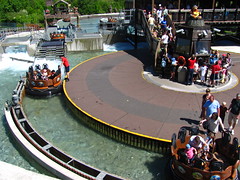 to guests with, I had to wonder if the park had been converted from a different original property or had relocated the entrance at some point in its history. When we got to the bottom we encountered our first real attraction in the Land of the Vikings: Viking’s River Splash (don’t you love the creative allusions and double meanings Legoland puts into all of their naming?) Despite some hesitancies concerning the degree of wetness we might endure (Dan had thought to bring his copy of Jane Austen we were supposed to be reading over the weekend), I insisted that we should give it a go as European river raft rides generally haven’t been real drenchers and it was likely to be one of the few big rides the park had to offer anyway. A fifteen minute wait (a bit longer than it should have been due to an apparent shortage of rafts) and we soon were careening downstream.
to guests with, I had to wonder if the park had been converted from a different original property or had relocated the entrance at some point in its history. When we got to the bottom we encountered our first real attraction in the Land of the Vikings: Viking’s River Splash (don’t you love the creative allusions and double meanings Legoland puts into all of their naming?) Despite some hesitancies concerning the degree of wetness we might endure (Dan had thought to bring his copy of Jane Austen we were supposed to be reading over the weekend), I insisted that we should give it a go as European river raft rides generally haven’t been real drenchers and it was likely to be one of the few big rides the park had to offer anyway. A fifteen minute wait (a bit longer than it should have been due to an apparent shortage of rafts) and we soon were careening downstream.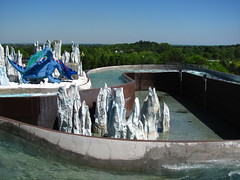
In general it was a fun ride mostly from our attempts to stay dry whenever a passing brick figure threatened to squirt water over our heads and a couple instances where a minor reorientation of position could have resulted in a much more unpleasant dousing than we were somehow narrowly able to avoid. While we agreed on our enjoyment of the experience there was also mutual consensus that the experience need not be repeated. This was also the first time that quality control became a more pressing issue on my mind. Most theme parks use river rapids as a chance to flex their creative themeing muscles, and while there were a few nice Lego set pieces along the way, the ride in general was surprisingly ghetto. Built awkwardly over a hillside, instead of floating through wooded landscaping as it typically the protocol for these rides, it was built over a giant, mostly drained reservoir with 10 foot tall bare concrete retaining walls everywhere you looked. Quite possibly the ugliest flume ride I’ve ever seen, and being familiar with many American parks that title is up against some steep competition.
unpleasant dousing than we were somehow narrowly able to avoid. While we agreed on our enjoyment of the experience there was also mutual consensus that the experience need not be repeated. This was also the first time that quality control became a more pressing issue on my mind. Most theme parks use river rapids as a chance to flex their creative themeing muscles, and while there were a few nice Lego set pieces along the way, the ride in general was surprisingly ghetto. Built awkwardly over a hillside, instead of floating through wooded landscaping as it typically the protocol for these rides, it was built over a giant, mostly drained reservoir with 10 foot tall bare concrete retaining walls everywhere you looked. Quite possibly the ugliest flume ride I’ve ever seen, and being familiar with many American parks that title is up against some steep competition.
A spinning tea-cups ride with a spider theme had some appeal but we decided it wasn’t likely worth it for the posted queue. Of more interest were the large Lego arachnids nearby and overhead. This is the biggest appeal of any Legoland park, having the sense of wonderment at being in a make-believe city where everything you see is made out of children’s toys. Of course the actual quantity of Legos relative to other building materials is rather small (at least outside of Miniland), mostly just a few statues or figures scattered around the midways, the ‘lands’ themselves are not made of Legos.
The thing I always found slightly dubious was how meticulous and perfectly created all of these Lego sculptures are. The spiders are excellent examples, the arrangement of the bricks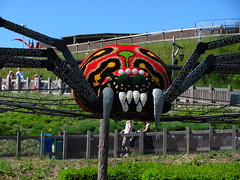 into layers conforming to perfectly smooth geometrics curvatures gives this toyland away as a place where adult engineers still rule. The Lego sculptures I remember from my childhood were a much more Dadaist endeavor, lumps of haphazardly formed bricks resembling more closely a primary-colored dog pile than whatever it was I was actually trying to recreate (at least before instruction guides started coming with them, but once playtime involved carefully following directions you were probably ‘old’ anyway).
into layers conforming to perfectly smooth geometrics curvatures gives this toyland away as a place where adult engineers still rule. The Lego sculptures I remember from my childhood were a much more Dadaist endeavor, lumps of haphazardly formed bricks resembling more closely a primary-colored dog pile than whatever it was I was actually trying to recreate (at least before instruction guides started coming with them, but once playtime involved carefully following directions you were probably ‘old’ anyway).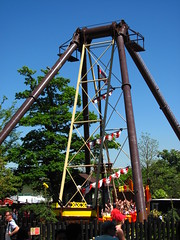
We found our next ride in the form of the Jolly Rocker, a HUSS Pirate Ship that allowed us entrance on after waiting only one cycle to load, but unfortunately after snagging a row as far back in the gondola as possible the cycle still proved to be one of the weakest I’ve ever experienced in a major amusement park. I know, I know, it’s for kids… but except in the case of toddlers most kids I know go the most crazy for high-rocking boats. I remember a time before I hit double digit when the best thing about these was to see how high off your seat you could get without the ride operator yelling at you to sit down. (“Hey, it’s not me, it’s the ride doing it!”) As we moved into the Knight’s Kingdom, an awkward request of my travel companions was needing to be made.
“Before anything else, would you mind if we try the Dragon’s Apprentice?”
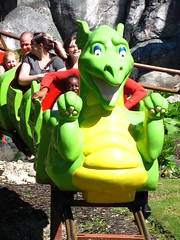 No objections were made against the petite spring green children’s coaster I was gesturing towards (quite possibly because it still represented one of the larger attractions on the map; I was worried after finishing the coasters how much more we would have left to ride that we could still fit in), although I suspect that if it had been disclosed to us at this point that it would be a solid 45 minutes before we were once again free to choose our next activity, even I would have backed down and said maybe later. While in the queue (which really wasn’t that long, only a reminder that kiddie coasters are not built for high throughput capacities) I tried to keep morale high by entertaining Mark and Dan with stories of how I keep track of all the roller coasters I’ve ever been on and this was to be my 346th roller coaster… we were ‘queuing for a cause’, as it were. This talk couldn’t last the full 45 minutes.
No objections were made against the petite spring green children’s coaster I was gesturing towards (quite possibly because it still represented one of the larger attractions on the map; I was worried after finishing the coasters how much more we would have left to ride that we could still fit in), although I suspect that if it had been disclosed to us at this point that it would be a solid 45 minutes before we were once again free to choose our next activity, even I would have backed down and said maybe later. While in the queue (which really wasn’t that long, only a reminder that kiddie coasters are not built for high throughput capacities) I tried to keep morale high by entertaining Mark and Dan with stories of how I keep track of all the roller coasters I’ve ever been on and this was to be my 346th roller coaster… we were ‘queuing for a cause’, as it were. This talk couldn’t last the full 45 minutes.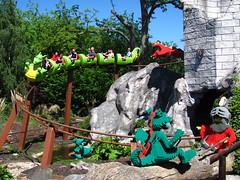
In any other context the ride wouldn’t have been worth the wait, although here it actually was one of the more successful attractions of our visit, our two cycles affected by some not insignificant lateral forces with a nice spiraling first drop around a castle ruin.
I was greeted with some minor celebratory remarks over hitting the big three-four-six as we made our way down the exit ramp… the fact that it was intended somewhat sincerely made it all the more embarrassing for this coaster credit junkie. (It’s when friends and family start to become drawn into your addictions that you know it’s time to seek help.)
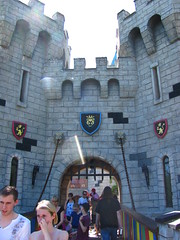 Within a large castle fortress was for us the park’s starring attraction, The Dragon. Now this was finally a bit more like what I was expecting from Legoland, a multilayered, immersive structure and a pretty cool, original ride on the inside as well. From a queue leading us around the upper battlements and then descending into the lower depths, the dark, dungeon-esque loading platform was more ‘serious’ than anywhere else in Legoland, although the presence of a few malapropos toy bricks added the requisite comic relief one expects from Legoland. Best of all, the operation of three trains meant we had to wait not more than two minutes before we had a front row to call our own.
Within a large castle fortress was for us the park’s starring attraction, The Dragon. Now this was finally a bit more like what I was expecting from Legoland, a multilayered, immersive structure and a pretty cool, original ride on the inside as well. From a queue leading us around the upper battlements and then descending into the lower depths, the dark, dungeon-esque loading platform was more ‘serious’ than anywhere else in Legoland, although the presence of a few malapropos toy bricks added the requisite comic relief one expects from Legoland. Best of all, the operation of three trains meant we had to wait not more than two minutes before we had a front row to call our own.
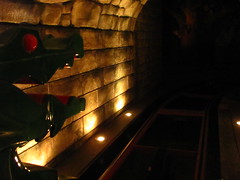 The Dragon starts out with what I’d call the only genuinely proper dark ride segment on a coaster I’ve ever been on. Most other coasters that try to start with something of this nature usually involve just stopping in a small showroom for a few seconds (Furius Baco), breezing through a short indoor set at 10mph (Blue Fire), or are still behaving more as an indoor coaster than a legit dark ride (Exterminator).
The Dragon starts out with what I’d call the only genuinely proper dark ride segment on a coaster I’ve ever been on. Most other coasters that try to start with something of this nature usually involve just stopping in a small showroom for a few seconds (Furius Baco), breezing through a short indoor set at 10mph (Blue Fire), or are still behaving more as an indoor coaster than a legit dark ride (Exterminator).
Using numerous dark ride tactics such as dramatic lighting as you pass and scenes built to be examined rather than briefly glimpsed, after a minute or two of dark twists and turns (including coming face to face with a large, snarling Lego dragon you could probably touch if not for CCTV), we start an ascent back into the sunlight on a tire drive lift.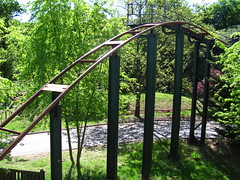
The first drop is a surprisingly steep one for a family coaster (at least seemingly so for those in the rear seats), we dive beneath a tree and make a long figure eight very close to ground level (sculpted around the track in a manner similar to the Ultimate) before we curve up into another short s-turning lift hill. The train always got stopped briefly at this second crest due to the three train operation and lack of sufficient blocking space at the end of the layout. Greeted with another drop about as thrilling as the first (thanks to a close headchopper with another piece of track followed immediately with an underground tunnel) we emerge for a second ground level figure eight, the excitement generated by the rapid burst of speed and visceral thrills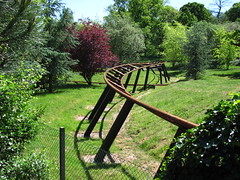 in the tunnel quickly diminishing as our dragon train runs dry on speed and needs to be helped back up to station level with more uneven tire drives.
in the tunnel quickly diminishing as our dragon train runs dry on speed and needs to be helped back up to station level with more uneven tire drives.
It seemed we had our first real winner at Legoland, as we unanimously agreed a second ride was in order, this time under walk-on conditions. Mark and I took the very back row while Dan caught up on his Jane Austen in the seat ahead of us. He later regretted not buying the on-ride photo that resulted. We moved on to contemplate giving the Pirate Falls log flume a try, which seemed like the only large-size attraction left for us to try, but the combined observed phenomena of a lengthy queue and wet disembarking patrons meant we couldn’t reach a consensus, and so continued our quest for the next worthwhile attraction.
 My map suggested the Laser Raiders interactive dark ride as perhaps our next (and last) ride suitable for grown-ups. We found the queue for this one likewise was overly long (why weren’t more of these people over at the Dragon, that ride kicks ass and doesn’t have much of a wait for it?), and we were generally not appeased by the presence of Q-Bot users who got to skip ahead of us, causing our wait under a hot themed tent area that much more intolerable. This continued a debate over the morality of such line-cutting services (remember we were all in London for a philosophy program discussing ethics and English literature, so conversations invariably drifted towards applying learned moral principles to ridiculous subject matter; i.e., what if you have a Kantian and a utilitarian trapped in the same room and one has to eat the other to survive otherwise neither will, and the utilitarian realizes the Kantian is of greater use to society, does this mean the utilitarian should force-feed himself to the Kantian? Even more vexing: is it ethical to pick your nose? The debate still rages, but I digress much too far).
My map suggested the Laser Raiders interactive dark ride as perhaps our next (and last) ride suitable for grown-ups. We found the queue for this one likewise was overly long (why weren’t more of these people over at the Dragon, that ride kicks ass and doesn’t have much of a wait for it?), and we were generally not appeased by the presence of Q-Bot users who got to skip ahead of us, causing our wait under a hot themed tent area that much more intolerable. This continued a debate over the morality of such line-cutting services (remember we were all in London for a philosophy program discussing ethics and English literature, so conversations invariably drifted towards applying learned moral principles to ridiculous subject matter; i.e., what if you have a Kantian and a utilitarian trapped in the same room and one has to eat the other to survive otherwise neither will, and the utilitarian realizes the Kantian is of greater use to society, does this mean the utilitarian should force-feed himself to the Kantian? Even more vexing: is it ethical to pick your nose? The debate still rages, but I digress much too far).
Anyway, Dan advocated that there was nothing wrong with Q-Bots as the park owns all the resources and so they should decide how to distribute them amongst their guests, while I pointed out that the park is profiting by a burden paid by others, with Mark tending to favor my side. Nevertheless we all agreed that Legoland was exhibiting bad moral character when the queue got held up for nearly fifteen minutes after the attendant had to close a gate to let the miniature railway track pass through (again, bad design choice), and then forgot to return to reopen the gate for us, as after we finished I noted how the large display of onride photos showed at least twenty cars before us had been sent out empty while we continued to wait. Lame.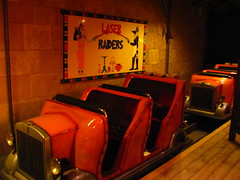
The ride itself was equally lame, an exceedingly basic Sally laser shooter with the cheap style neon cut-out props and the never-ending pew-pew-pew of guns that fail shoot properly. Despite being the “professional reviewer” of the bunch I wasn’t even the first to comment on this before we had finished, as the low opinion of the Laser Raiders (especially given the time waiting for it) was that patently obvious to all. I’d have thought Legoland to be one of the first places capable of putting on a really good dark ride, but this sadly was not the case.
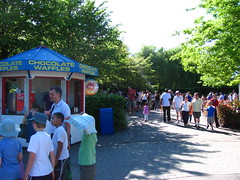 After we said our minds about the Laser Raiders we suffered a bit of an existential crisis when we realized we had exhausted the list of attractions readily available for the over-52 inch crowd and had no further objectives to fulfill. So we wandered the rest of the park layout over by where I think the old Jungle Coaster used to be before it was removed last year over complaints about the noise and a failed (but somewhat humorous) attempt to silence it. The park seemed to become more crowded the further we ventured, odd considering that the best rides seemed to be in the other direction. While a few other clever interactive children’s rides were found such as a large driving school they seemed not suitable for us. I was later told that the Wave Surfer ride is one of Legoland’s best, which I’m sad to say we neglected to scout out
After we said our minds about the Laser Raiders we suffered a bit of an existential crisis when we realized we had exhausted the list of attractions readily available for the over-52 inch crowd and had no further objectives to fulfill. So we wandered the rest of the park layout over by where I think the old Jungle Coaster used to be before it was removed last year over complaints about the noise and a failed (but somewhat humorous) attempt to silence it. The park seemed to become more crowded the further we ventured, odd considering that the best rides seemed to be in the other direction. While a few other clever interactive children’s rides were found such as a large driving school they seemed not suitable for us. I was later told that the Wave Surfer ride is one of Legoland’s best, which I’m sad to say we neglected to scout out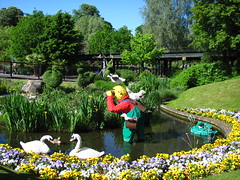 but given our disinclination towards getting wet I think it probably would have been voted down regardless. The long sun and humid weather was starting to get to us… was this England or Alabama we were in, and why is it I’m always hearing self-deprecating remarks from Brits that they’ve maybe seen the sun twice in their natural lives when I got more bright and clear days over four weeks in London than I did over four months in Rome? Anyway, we settled on the last big tick on our checklists, Miniland. Rather than say any more words, I’ll just let this photo slideshow sum it up for me. Just a note, my camera was running low on batteries so I ended up with a very conservative collection of 42 photos compared to what I otherwise normally would have taken.
but given our disinclination towards getting wet I think it probably would have been voted down regardless. The long sun and humid weather was starting to get to us… was this England or Alabama we were in, and why is it I’m always hearing self-deprecating remarks from Brits that they’ve maybe seen the sun twice in their natural lives when I got more bright and clear days over four weeks in London than I did over four months in Rome? Anyway, we settled on the last big tick on our checklists, Miniland. Rather than say any more words, I’ll just let this photo slideshow sum it up for me. Just a note, my camera was running low on batteries so I ended up with a very conservative collection of 42 photos compared to what I otherwise normally would have taken.
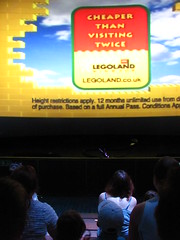 After a solid half hour we finished the day trying to get what use-value we could out of the Imagination Center, an area that would again hold more interest for younger audiences, not that you’re ever too old to stop and get an ice cream (oh wait, the prices are ridiculously expensive and none of the nearby tables have been cleaned in the past couple hours… never mind). The Imagination Theatre 4D movie seemed promising so we caught the last show of the day, a rather odd short featuring voiceless Lego actors in a medieval siege on a castle using some of the worst CG animation I’ve ever seen that only added to the kitsch. The odd thing about these “4D” movies is how much dramatic tension can be generated even despite some pretty lousy story-telling just through the promise that the fourth wall separating you from the events on screen will be broken at some random time by a jet of water pointed at you from a currently unseen source. This makes the dramaturgic arc peak not at the rescue of the princess but at the random shot of charging footsteps through a puddle. And it does a surprisingly good job at it too, the mere sight of standing water in a scene achieving a Freudian level of suspense akin to the sight of oranges in the Godfather films.
After a solid half hour we finished the day trying to get what use-value we could out of the Imagination Center, an area that would again hold more interest for younger audiences, not that you’re ever too old to stop and get an ice cream (oh wait, the prices are ridiculously expensive and none of the nearby tables have been cleaned in the past couple hours… never mind). The Imagination Theatre 4D movie seemed promising so we caught the last show of the day, a rather odd short featuring voiceless Lego actors in a medieval siege on a castle using some of the worst CG animation I’ve ever seen that only added to the kitsch. The odd thing about these “4D” movies is how much dramatic tension can be generated even despite some pretty lousy story-telling just through the promise that the fourth wall separating you from the events on screen will be broken at some random time by a jet of water pointed at you from a currently unseen source. This makes the dramaturgic arc peak not at the rescue of the princess but at the random shot of charging footsteps through a puddle. And it does a surprisingly good job at it too, the mere sight of standing water in a scene achieving a Freudian level of suspense akin to the sight of oranges in the Godfather films.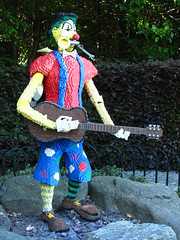
The theatre itself was just a final example of Legoland going cheaper than one would expect of a park with their stature and success. Rather than state of the art sound systems and giant screens with individually padded seats we were looking at a small white screen draped over the front of what appeared to be a repurposed ampitheater sitting in rows of hard wooden benches that lacked even a seat back. Maybe we just didn’t see the better parts of the park and the large crowds impeded full enjoyment of those areas that were most pleasant, but I’d still have to say that as we boarded the bus back to Windsor, regardless of what I was expecting from Legoland I expected something a bit classier than what was actually there. Of the three of us I was possibly the most jaded towards the park, as both Dan and Mark seemed satisfied with the day. Having friends along undoubtedly made my time at Legoland infinitely better than it would have been made had I done my usual routine of visiting a park alone only focused on getting as many rides and photos during the day a possible, and I thank Dan and Mark for their companionship.
Rather than jump back on the train we took the time to explore more of Windsor and Eton, crossing the Thames to have a look at Eton College before getting a dinner at an Indian restaurant by Dan’s suggestion… my first exposure to Indian food (much more popular in the UK than the States, undoubtedly due to certain historical associations between the two nations) and I found it generally quite agreeable with my palate. By the time our train departed Windsor for London Waterloo against the golden sun any further conversation had been exhausted as we were all, to borrow a local term, completely knackered.
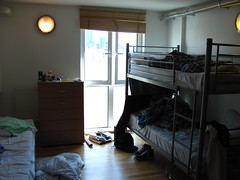













You hit that bang on the head for Legoland. It’s one of my four local parks and is the one I tend to avoid. Great review yet again!
It need not be a park to avoid, but they should at least repaint their fading entrance sign first.
Legoland, I know it so well.
As I’ve previously stated it’s great to see such in-depth analysis, but on this occasion I was surprised to notice a common reference which I’m not even sure you’re aware of. At numerous points you refer to the oddity which is the second midway and ride queue times but would it surprise you to know they are all linked?
You are right about the original property. The park was once Windsor Safari Park and maintains several aspects of the original layout, including the Hill Train. However the ad-hoc midway was a recent addition in 2008 and not part of the parks original layout. The original midway snakes down the side of the park and is a unique and quite clever design. When you comment later on how quite The Dragon was it is the parks midway layout which is partly to thank.
I’ll try and keep this short (but presumably fail). As I’m sure you’re aware the flow of guests through a park will have its own signature pattern based on ride location, target audience, capacity and several other minor factors. An ideal layout aims to filter guests with large capacity and catering outlets along the midway and focal attractions edging the rim of the park. Although not immediately apparent Legoland have closely followed the ideal and taken it a step further.
The easiest way I can explain is with an example. Take 2004 when The Jungle Coaster had just opened and the parks layout made the most sense. Imagine the start of the day, when the guests have arrived but are being held back at the top of the midway. The barrier drops and the stamped begins. Just like any other park some guests will go faster and others slow but with no rides everyone heads in the same direction. The first major attraction is Miniland at the very bottom of the slope. By this point the guests are very spread out and presented with a near limitless capacity attraction which happens to be the most renown. While most rationally minded would save Miniland for later Legoland plays it’s trump card by allowing a child’s curiosity to influence a parents judgments. Do they push on or succumb to their kids desire to stay? Continue on and every corner offers other choice like this. As a result it can be several hours before the secluded areas of the park reach capacity and then the reveres towards the end of the day.
It’s an elegant design which effortlessly deals with the outrageous queues British parks are always falling foul too. Unfortunately recent projects have failed to make use of the parks layout. Laser Raiders has so many design flaws I sometimes wonder if they were doing it on purpose.
We didn’t get there until the afternoon so the park had already filled all the midways. I don’t think the problem was uneven capacity but not enough (save for the Dragon). I got the sense that the reputation was much bigger than the park itself, and the majority of stuff we saw outside of Miniland and the Dragon was a level or two lower in quality than I would have expected from Legoland.
I think arriving at the front gate and seeing the black block entrance letters chipped and fading left an impression I was never able to shake for the rest of the day.